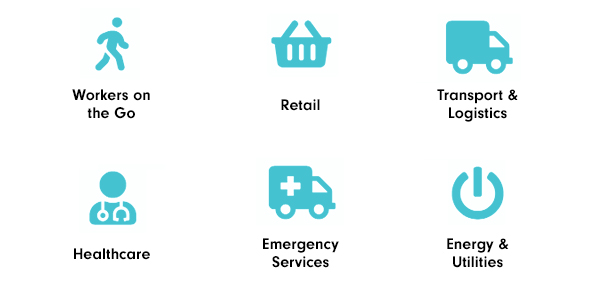An Introduction to eSIM
eSIM is a major evolution in SIM technology delivering significant business benefits. The service is completely network-agnostic meaning it automatically offers the best possible service in any given location. The eSIM will always enable devices to connect to the best cellular network with the ability for us to manually select a network as well. As our eSIMs are available as a triple cut SIM card (as well as the embedded MFF2 format) they are compatible with any device with a SIM slot.
When installed into your devices, the SIM will search for the strongest signal giving you the best connectivity that is available, regardless of your devices location.
Our eSIM solution is perfect for workers on the go that travel to remote locations who need constant connectivity and flexible data. Retail point of sale systems, emergency services, transport and logistic organisations also receive a huge benefit where continual connectivity in ever changing locations is essential. There is no need for the headache of pre planning which location has the best coverage as you will stay connected with the strongest option.
eSIM use cases

The following are some of the major differences between standard SIMs and eSIMs and the reasons why they are significant.
eSIMs can be re-programmed ‘Over-The-Air’ (OTA)
There are many reasons why you might want to update a SIM card, examples include when an alternative Mobile Network with better coverage becomes available.
If that SIM card is in your office, physically swapping the SIM is a quick and easy. However, if you are a business with thousands of SIM cards across multiple sites, this becomes a serious undertaking. It is further complicated if that estate of SIMs is inaccessible as they are embedded in devices or because they are in geographically remote or hard to access locations. The complication might simply be that they are spread across a large geographic area, spanning multiple countries or even continents.
eSIM technology means the SIM or an estate of SIMs do not need to be swapped out, instead they can be re-programmed Over-The-Air.
The Mobile Network Operators do not own the eSIMs
Standard SIMs are owned by an Mobile Network Operator (MNO). If you have one of these SIMs, you are restricted with what the MNO is able to offer you. When originally choosing the MNO, you will have hopefully been given the best deal available to you at that given time. If something changes and the you decide for whatever reason you want to swap MNOs, with standard SIM cards this inevitably means a truck roll and swapping out an estate of SIMs.
eSIMs are not owned by the MNO and so it is much more agile and flexible compared with an MNO offering as you are not restricted to a solitary choice of service.
eSIMs can hold multiple profiles
Traditionally a standard SIM holds one SIM profile – all the information necessary (e.g. the International Mobile Subscriber Identity - IMSI) to give one connectivity option to each SIM card.
eSIM can be seen as a container for multiple SIM profiles (which can be added to / updated Over The Air). A single eSIM can potentially have multiple connectivity options at any given time. Every eSIM is assigned a ‘bootstrap profile’ after it has been manufactured which means that the SIM can connect wherever it is activated around the globe.
